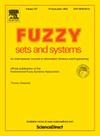Optimal weights and feasible orness of ordered weighted averaging functions in the framework of Tsallis entropy
IF 2.7
1区 数学
Q2 COMPUTER SCIENCE, THEORY & METHODS
引用次数: 0
Abstract
We discuss the application of the maximum entropy principle to the strict weighting vectors of ordered weighted averaging functions with a given orness. The problem has been thoroughly investigated by O'Hagan, Filev and Yager, and Fullér and Majlender in the context of the classical Shannon entropy. In this paper we extend the analysis to the more general context of Tsallis entropy for positive parameter values, which reduces to Shannon entropy in the unit parameter case. In our approach, whose key element is the convenient choice of a composite Lagrange multiplier, the existence of an optimal and monotonic strict weighting vector is proven for a feasible orness interval which depends on the Tsallis entropy parameter. In the small parameter domain (under unit) the feasible orness interval remains the full unit interval, as in the standard Shannon entropy case. On the other hand, in the large parameter domain (over unit) the feasible orness interval reduces to a symmetric interval around the neutral orness , which gradually reduces for increasing values of the Tsallis entropy parameter.
Tsallis熵框架下有序加权平均函数的最优权值和可行度
讨论了最大熵原理在给定值的有序加权平均函数的严格加权向量上的应用。O'Hagan、Filev和Yager以及full和Majlender在经典香农熵的背景下对这个问题进行了彻底的研究。在本文中,我们将分析扩展到更一般的Tsallis熵的情况下,对于正参数值,它可以简化为单位参数情况下的Shannon熵。在我们的方法中,其关键因素是方便地选择复合拉格朗日乘子,对于依赖于Tsallis熵参数的可行性区间(Ωminγ,Ωmaxγ)证明了最优单调严格加权向量的存在性。在小参数域(单位下)可行度区间保持完整的单位区间,如在标准香农熵情况下。另一方面,在大参数域中(单位上),可行度区间减小为中性度Ω=1/2周围的对称区间,随着Tsallis熵参数的增大,可行度区间逐渐减小。
本文章由计算机程序翻译,如有差异,请以英文原文为准。
求助全文
约1分钟内获得全文
求助全文
来源期刊

Fuzzy Sets and Systems
数学-计算机:理论方法
CiteScore
6.50
自引率
17.90%
发文量
321
审稿时长
6.1 months
期刊介绍:
Since its launching in 1978, the journal Fuzzy Sets and Systems has been devoted to the international advancement of the theory and application of fuzzy sets and systems. The theory of fuzzy sets now encompasses a well organized corpus of basic notions including (and not restricted to) aggregation operations, a generalized theory of relations, specific measures of information content, a calculus of fuzzy numbers. Fuzzy sets are also the cornerstone of a non-additive uncertainty theory, namely possibility theory, and of a versatile tool for both linguistic and numerical modeling: fuzzy rule-based systems. Numerous works now combine fuzzy concepts with other scientific disciplines as well as modern technologies.
In mathematics fuzzy sets have triggered new research topics in connection with category theory, topology, algebra, analysis. Fuzzy sets are also part of a recent trend in the study of generalized measures and integrals, and are combined with statistical methods. Furthermore, fuzzy sets have strong logical underpinnings in the tradition of many-valued logics.
 求助内容:
求助内容: 应助结果提醒方式:
应助结果提醒方式:


